| Genus List | Species List | Genus Overview |
Key to Myrmelachista of Costa Rica
Go to key for queens, males
WORKERS
10a. Antenna with 10 segments; mesosoma strongly hourglass-shaped, with strong constriction at metanotal groove; color dark brown to black: 20
10b. Antenna with 9 segments; mesosoma not strongly hourglass-shaped, moderately constricted at metanotal groove; color variable, from yellow orange to red brown to black: 30
20a. Surface of head and mesosoma shagreened; HW greater than 0.50mm: zeledoni
20b. Surface of head and much of mesosoma smooth and shiny; HW less than 0.48mm: mexicana
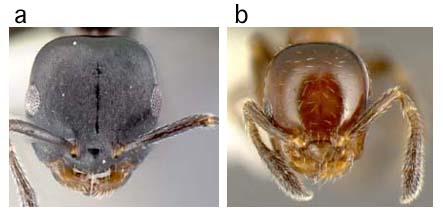
30a. Color nearly uniform light yellow orange or with some degree of infuscation on gaster; if clearly bicolored with orange head and mesosoma and dark gaster, pubescence on sides of head and on hind tibia usually abundant, suberect, OI usually less than 22: 40
30b. Color black to red brown, usually either uniform red brown or with dark head and gaster and mottled light and dark brown mesosoma; if clearly bicolored, pubescence on sides of head very sparse and fully appressed, pilosity on hind tibia fully appressed, and OI greater than 21: 100

40a. Maxillary palpus always 6-segmented; HW of larger workers usually greater than 0.65mm: 50
40b. Maxillary palpus always 5-segmented; HW of larger workers usually less than 0.65mm (the following set of species cannot be reliably distinguished with workers but can be differentiated with queens): 60
50a. Infuscation of gastral tergites weak, confined to posterior third or less of tergites; nests in live stems of various plants in southern mountains of Costa Rica: meganaranja
50b. Infuscation of gastral tergites more extensive, dark brown and covering 2/3 or more of tergite; nests in one species of understory Guarea in Cordillera de Tilarán, Costa Rica: flavoguarea

60a. Gastral tergites completely yellow, without posterior band of infuscation; hind tibia with suberect pilosity: 70
60b. Gastral tergites with variably developed infuscated band posteriorly; hind tibia with suberect or appressed pilosity: 80

70a. Head of larger workers relatively broad, CI 98-103; Atlantic slope: flavocotea
70b. Head of larger workers relatively narrow, CI 87-95; southern Pacific slope: lauropacifica
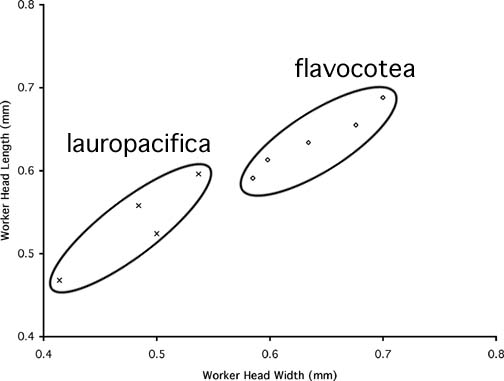
80a. Hind tibia with pilosity fully appressed: nigrocotea
80b. Hind tibia with pilosity subdecumbent to suberect: 90
90a. Side of head with projecting erect setae, the longest of which are similar in length to length of first funicular segment; Atlantic slope: lauroatlantica
90b. Side of head with projecting setae subdecumbent, very short, much shorter than length of first funicular segment; montane areas and southern Pacific lowlands: haberi and osa

100a. Color solid black; clypeus bulging; mandible with teeth 4 and 5 (counting from apex) separated by a wide diastema, teeth 1-4 more closely and evenly spaced; HW of larger workers 0.75mm or greater: cooperi
100b. Color variable; clypeus not strongly bulging; mandible without diastema between teeth 4 and 5, all 5 teeth relatively evenly spaced; HW of larger workers usually less than about 0.70mm: 110

110a. Head relatively elongate and subrectangular, CI 89-95; mandible punctatorugose; sides of head with pubescence sparse and very short, subdecumbent to fully appressed: longiceps
110b. Head relatively shorter, often somewhat cordate, CI 92-107; mandible usually smooth and shining; pubescence on side of head variable, from sparse and fully appressed to abundant and suberect (workers of plebecula and joycei cannot always be distinguished): 120

120a. Often bicolored, with light red brown head and mesosoma, dark gaster, but may have same coloration as joycei; pubescence on side of head usually sparse, short, fully appressed; pilosity on hind tibia usually appressed; eyes relatively larger, OI 22-25; HW of larger workers usually less than about 0.53mm (see figure above): plebecula
120b. Never bicolored (except nanitics), head and gaster dark brown, mesosoma variably mottled light and dark red brown; pubescence on side of head and hind tibia subdecumbent; eyes relatively smaller, OI 19-21; HW of larger workers often greater than 0.53mm: joycei

QUEENS (Costa Rica)
10a. Antenna with 10 segments; color dark brown to black: 20
10b. Antenna with 9 segments; color variable, from yellow orange to red brown to black: 40
20a. Mandible strongly falcate; head dorsoventrally flattened: cooperi
20b. Mandible subtriangular with differentiated basal and masticatory margin; head not strongly dorsoventrally flattened: 30
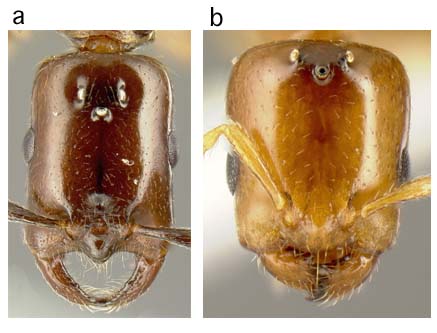
30a. Face weakly roughened or sericeous, not strongly shining; HW greater than 0.8mm: zeledoni
30b. Face smooth and shiny; HW less than 0.6mm: mexicana

40a. Head orange: 50
40b. Head dark red brown to black: 90
50a. HL greater than 1.2mm: 60
50b. HL less than 1.2mm: 70
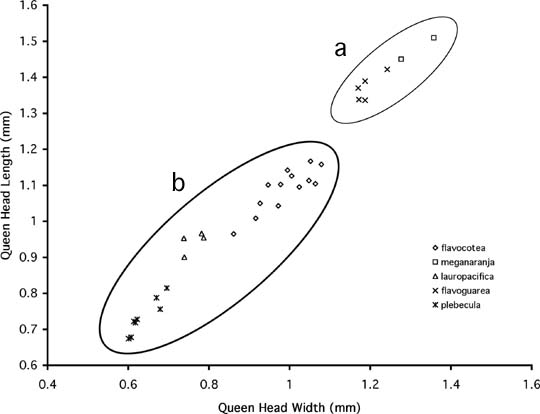
60a. Gaster solid dark brown; obligate inhabitant of understory Guarea in Cordillera de Tilarán: flavoguarea
60b. Gaster yellow orange with narrow infuscated bands medially; non-specialist inhabitant of live stems in Cordillera de Talamanca: meganaranja
70a. Sides of head and hind tibia with pilosity (pubescence or longer setae) completely appressed; HL less than 0.85mm; eyes relatively large, OI greater than 30; ocelli small, OcI 4-7; generalist inhabitant of live and dead stems: plebecula (also keys elsewhere due to variability in head color)
70b. Sides of head and hind tibia with subdecumbent to suberect pilosity; HL greater than 0.85mm; eye size variable, OI 27-37; ocelli larger, OcI 6-10; specialist inhabitant of understory Ocotea: 80
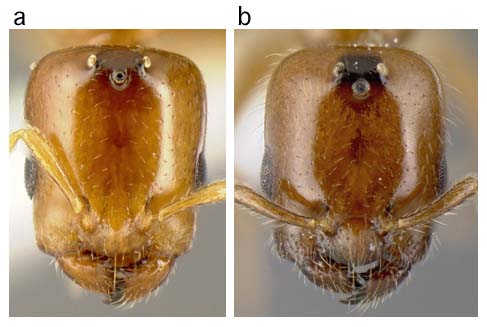
80a. Eyes relatively small, OI 27-31; HW greater than 0.8mm; Atlantic slope and central Cordilleras: flavocotea
80b. Eyes larger, OI 33-37; HW less than 0.8mm; southern Pacific lowlands: lauropacifica

90a. HW less than 0.7mm; generalist inhabitant of live and dead stems: plebecula
90b. HW greater than 0.7mm; specialist or generalist inhabitant of live stems: 100

100a. HL usually between 0.8-1.2mm; head relatively broad, CI 87-98; eyes relatively small, OI less than 30, often around 27; ocelli very small, OW often less than 0.05mm; mandible smooth and shining or weakly rugose; maxillary palpus always 6-segmented (workers brown to mottled red brown; common cloud forest species nesting in many species of trees): joycei
100b. HL between 0.8-1.4mm; CI 79-93; OI 23-33; OW 0.04-0.10mm; mandible punctatorugose; maxillary palpus 5 or 6-segmented: 110
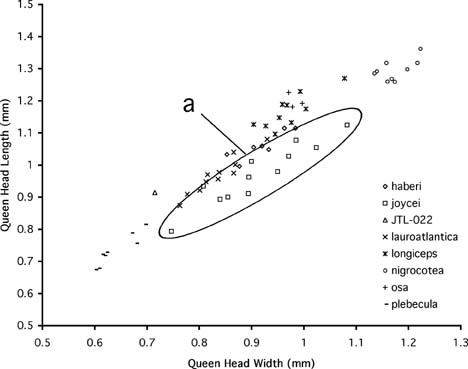
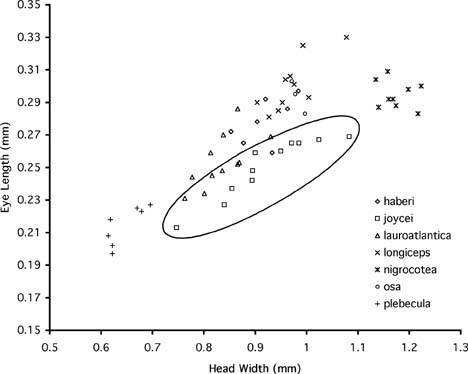
110a. HW greater than 1.1mm; head relatively broad, CI 88-93; eyes relatively small, OI 23-27; much of face slightly roughened, dull, not strongly shining: nigrocotea
110b. HW less than 1.1mm, if approaching 1.1mm then head relatively elongate (CI less than 86); OI greater than 27; most of face smooth and strongly shining: 120
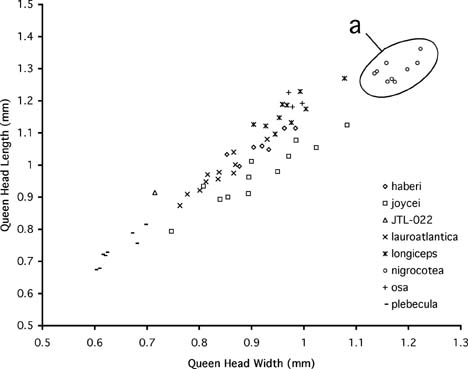

120a. In full face view with long erect setae projecting from sides of head; maxillary palpus 5-segmented: lauroatlantica
120b. Sides of head with short appressed to suberect pubescence, without longer erect setae (figure is of haberi, which among following species most approaches lauroatlantica in pilosity); maxillary palpus 5 or 6-segmented: 130

130a. Workers dark red brown (longiceps queens bridge the morphological gap between haberi and osa and cannot be distinguished from either): longiceps
130b. Workers yellow orange: 140
140a. Maxillary palpus 5-segmented; CI 83-89; HL 1.00-1.12; sides of head rounding more gradually into rear margin: haberi
140b. Maxillary palpus 6-segmented; CI 79-84; HL 1.18-1.23; head more sharply rectangular, sides flat and more abruptly rounding into flat rear margin: osa
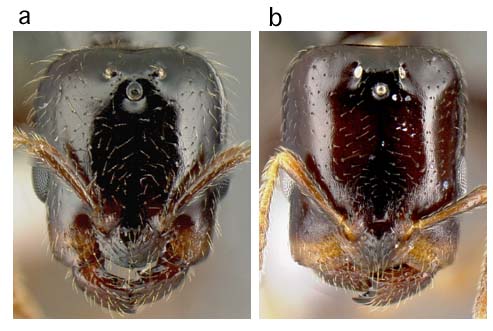
MALES
The male of M. osa is unknown.
10a. Antenna with 11 segments; apodeme of penial valve meeting dorsal margin of blade at nearly right angle: 20
10b. Antenna with 10 segments; apodeme of penial valve rounding into dorsal margin at obtuse angle: 40

20a. Pygostyles absent: mexicana
20b. Pygostyles present: 30
30a. Paramere broadly triangular: cooperi
30b. Paramere more elongate, with parallel sides before bluntly rounded apex: zeledoni
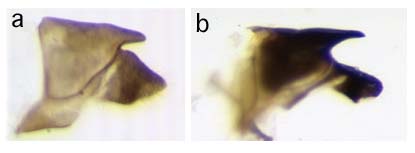
40a. Basiparamere lobe absent or reduced to short triangular tooth, much shorter than paramere; cuspis absent: 50
40b. Basiparamere lobe well developed; cuspis present or absent: 60

50a. Ocelli small, width of median ocellus less than distance between median and lateral ocellus; petiolar dorsum with few to no erect setae: plebecula
50b. Ocelli large, width of median ocellus greater than distance between median and lateral ocellus; petiolar dorsum with conspicuous tuft of erect setae: lauropacifica

60a. Pygostyles present; basiparamere lobes and parameres very long and thin: 70
60b. Pygostyles absent or reduced to tiny unsclerotized remnants; basiparamere lobes and parameres thin or broad: 80
70a. Digitus evenly tapered to apex: flavoguarea
70b. Digitus broadening apically to paddle-shaped apex: meganaranja

80a. Digitus greatly expanded distally and with thickened posterodorsal and posterior margins, forming a bulla at apex: longiceps
80b. Digitus evenly tapered or scimitar-shaped, never forming a bulla at apex: 90
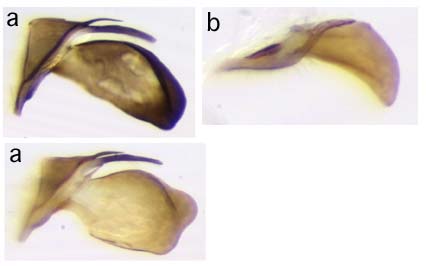
90a. Cuspis absent or reduced to sharply triangular or spine-like process, closely appressed to inner surface of paramere and distant from digitus: 100
90b. Cuspis present and subrectangular, separated from inner surface of paramere, apex sometimes approaching or touching dorsal margin of digitus: 120
100a. Digitus scimitar-shaped (Fig. 10B); cuspis present as a spiniform tooth; maxillary palpus always 6-segmented: joycei
100b. Digitus more evenly tapered from base to apex; cuspis as above or absent; maxillary palpus 5 or 6-segmented: 110
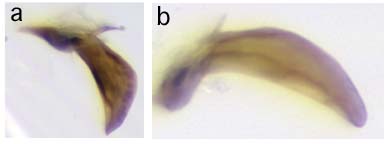
110a. Maxillary palpus 5-segmented; cuspis present as a small triangular or spiniform tooth: haberi
110b. Maxillary palpus 6-segmented; cuspis absent: lauropacifica
120a. Digitus thin and evenly tapered: lauroatlantica
120b. Digitus scimitar-shaped, broadening apically: 130

130a. Basiparamere lobe and paramere very long and thin; digitus rounded apically: longiceps
130b. Basiparamere lobe and paramere broad at the base, shorter; digitus tapering to a point at apex: 140
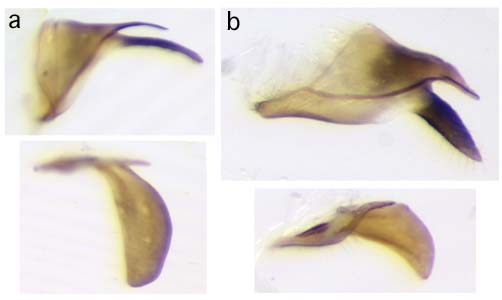
140a. Ocelli relatively large, width of median ocellus usually greater than distance between median and lateral ocellus; distance between lateral ocelli about equal to distance from lateral ocellus to compound eye: flavocotea
140b. Ocelli relatively small, width of median ocellus usually less than distance between median and lateral ocellus; distance between lateral ocelli less than distance from lateral ocellus to compound eye: nigrocotea

Page author:
John T. Longino, The Evergreen State College, Olympia WA 98505
USA.longinoj@evergreen.edu
Date of this version: 20 March 2006.
Previous versions of this page:
 Go back to top
Go back to top
Go to Ants of Costa Rica Homepage































